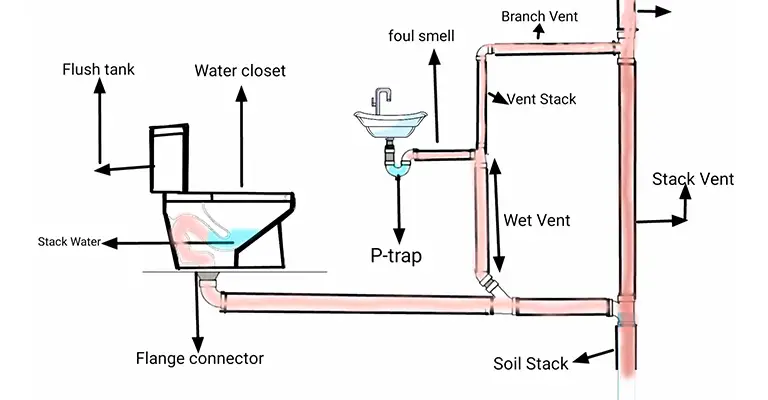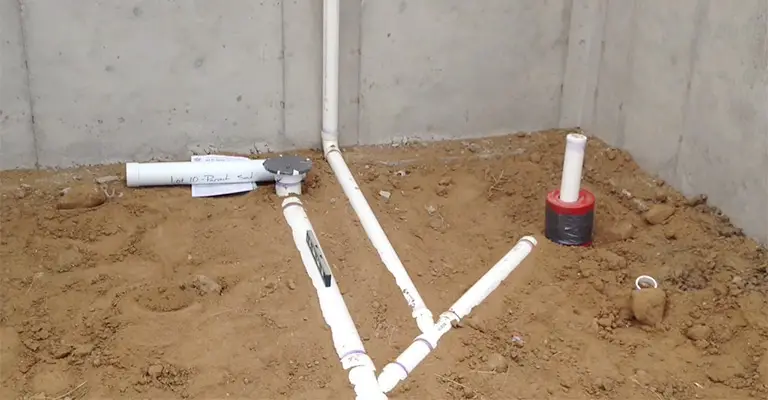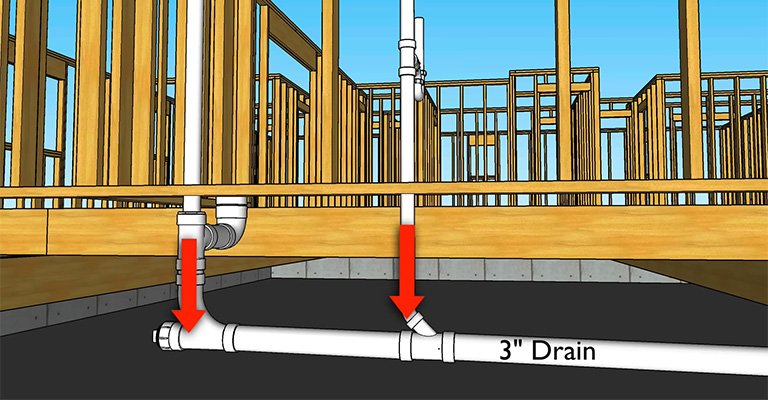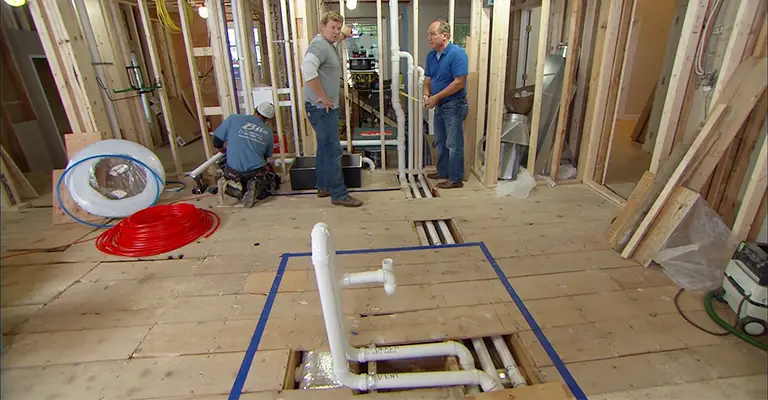The distance between a toilet and a vent stack in a plumbing system can vary based on local plumbing codes and the specific layout of the plumbing system.
However, there are some general guidelines that are often followed in plumbing design to ensure proper ventilation and drainage.
Keep in mind that these guidelines might not be up-to-date, so it’s essential to consult your local plumbing codes and regulations for the most accurate information.
Standard Toilet Vent Distance
So, how far can a toilet be from a vent stack? In accordance with the UPC, there should not be more than 6 feet between your trap and the vent.
The vent must be located within six feet of any trap ways connecting to the drain line in order to function properly.
In the past, a common rule of thumb was to keep the distance between a toilet and a vent stack to a maximum of 6 feet (approximately 1.8 meters).
This distance was based on the idea that the venting system should be able to effectively prevent air pressure issues and siphoning that could lead to trap seal loss or slow drainage.
However, modern plumbing codes and design practices can vary, and some jurisdictions might allow for greater distances depending on factors like pipe diameter, slope of the pipe, and the specific plumbing layout.
Some areas might require the use of additional venting methods or mechanical devices to ensure proper drainage and ventilation over longer distances.
It’s important to note that the goal of the venting system is to prevent issues like siphoning and air pressure imbalances.
Which could compromise the functioning of traps (the U-shaped bends in pipes that hold water to prevent sewer gases from entering buildings) and lead to odors or drainage problems.
If you’re designing or modifying a plumbing system, it’s recommended to consult with a professional plumber and adhere to the local plumbing codes to ensure a safe and effective installation.
Distance Between the Toilet and Main Stack

Depending on the diameter of the waste line, the distance between the toilet and main stack will vary. It is recommended that the toilet be no more than 6 feet away from the stack if the waste line diameter is 3 inches.
If the waste line is 4 inches in diameter, the toilet should be no farther than 10 feet from the stack.
Due to the slope of the pipe, the diameter of the waste line affects the distance between the toilet and stack.
There should always be a drop rate of 14 inches per horizontal foot for the pipes. In order to maintain the correct slope, the toilet can be further away from the stack the larger the diameter.
Why Would You Measure the Distance Between the Toilet and Stack?

Moving your toilet requires measuring the distance between the toilet and stack. It is not necessary to measure the distance between the toilet and stack if your toilet is not being moved or changed.
Aspects of Moving a Toilet
The drain, water supply plumbing, and fixture need to be moved when you move a toilet. It is easy to move the fixture, but it is more difficult to move the drainage and water supply plumbing.
Moving the Toilet Drain
The bathroom floor is covered with drainage pipes. A typical route for these pipes is between other pipes and joists in the flooring. They are normally 3- to 4-inches in diameter.
The drop rate of drainage pipes determines the proper flow of waste, which is controlled by gravity.
An average of 14 inches should drop from the drainage pipes per horizontal foot vertically. Because of this, it is important for the toilet to be separated from the stack at an appropriate distance.
Waste lines with a diameter of 3 inches should be kept at a distance of at least 6 feet from the toilet. Waste lines with diameters of four inches should be kept at a maximum distance of ten feet from the toilet.
Moving the Water Supply
The water supply can be moved once the toilet drain has been relocated. The distance between the toilet and main stack is not involved in this aspect, so it is less challenging.
It is much easier to move water supply pipes around because they are much smaller. The relocated supply line may need to be connected to the existing toilet supply line.
Why Is The Distance Between A Toilet And A Vent Stack Important?
The distance between a toilet and a vent stack is crucial for maintaining proper drainage and preventing issues like siphoning and trap seal loss.
The venting system ensures that air pressure remains balanced, allowing waste to flow effectively and preventing sewer gases from entering the building.
Can The Distance Between A Toilet And A Vent Stack Be Extended If Needed?

Depending on local codes and the plumbing layout, some jurisdictions might allow for extended distances between a toilet and a vent stack.
However, this often requires additional measures, such as larger pipe diameters, proper pipe slope, and potentially the use of mechanical venting devices.
What Happens If The Distance Between A Toilet And A Vent Stack Is Too Great?
If the distance between a toilet and a vent stack is too great without proper venting measures, it could lead to slow drainage, gurgling sounds, and potential trap seal loss. This can result in foul odors and unsanitary conditions within the building.
Can I Install A Toilet Without A Nearby Vent Stack?
In most plumbing systems, toilets require a proper venting system to function correctly.
Installing a toilet without a nearby vent stack can lead to drainage problems, sewer gas odors, and potential health hazards. Consult local plumbing codes and professionals before making such installations.
Are There Alternative Venting Methods For Longer Distances?
Yes, there are alternative venting methods that can be used for longer distances between fixtures and vent stacks.
These might include the use of air admittance valves (AAVs) or mechanical venting devices. However, the use of these methods should comply with local codes and regulations.
Should I Consult A Professional For Plumbing Installations Involving Venting?
Yes, it’s highly recommended to consult a professional plumber or plumbing engineer when designing or modifying plumbing systems involving venting.
They can ensure that the system is compliant with local codes, prevent potential issues, and ensure proper drainage and ventilation.
How Do I Find The Specific Plumbing Codes For My Area?
Plumbing codes can vary by region and jurisdiction. You can usually find local plumbing codes through your city or county’s building department or on their official website.
Consulting with a licensed plumber who is familiar with local codes can also be helpful.
Can I Rely On Older Guidelines For Toilet-Vent Distances?
It’s best to consult with current plumbing codes and regulations rather than relying solely on older guidelines.
Plumbing standards can evolve to accommodate new technologies and best practices, so it’s essential to have up-to-date information for a safe and effective plumbing system.
What Happens If I Don’t Follow Proper Venting Guidelines?
Failure to follow proper venting guidelines can result in poor drainage, sewer gas odors, and potential health and safety hazards.
It’s important to prioritize proper plumbing practices to maintain the functionality and safety of your plumbing system.
Conclusion
In conclusion, understanding the relationship between toilets and vent stacks in plumbing systems is essential for maintaining effective drainage, preventing odor issues, and ensuring a safe and sanitary environment within buildings.
While the specific distance between a toilet and a vent stack can vary based on local plumbing codes and design practices, it’s crucial to adhere to these regulations to avoid potential problems.
Proper venting systems play a pivotal role in preventing issues like siphoning, slow drainage, and trap seal loss, which can lead to foul odors and unsanitary conditions.
As plumbing codes and best practices evolve, it’s important to stay updated on the latest guidelines to ensure your plumbing system functions as intended.
When planning plumbing installations or modifications involving toilet-vent distances, it’s highly recommended to consult with professional plumbers or plumbing engineers.
Their expertise can help you design a system that complies with local codes, promotes efficient drainage, and maintains a healthy indoor environment.
By prioritizing proper venting and adhering to local regulations, you can ensure the longevity and functionality of your plumbing system.








